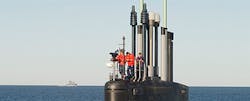Navy to buy an additional 16 Universal Modular Mast Systems from L-3 KEO in $15 million contract
Officials of the Naval Sea Systems Command in Washington on Friday announced a $15 million contract to L-3 KEO to provide 16 Universal Modular Mast (UMM) systems for the Navy's Virginia-class submarine fleet.
The Virginia-class is one of the first submarines without a traditional optical periscope that penetrates the vessel's pressure hull and extends upward to enable commanders of submerged submarines to view the scene on the surface. L-3 Communications (NYSE:LLL) acquired Kollmorgen Electro-Optical (KEO) in early 2012.
Related: Submarine designers rely on COTS to broaden undersea warfare missions
L-3 KEO's predecessor, Kollmorgen, installed the first workable periscope aboard a U.S. submarine in 1916, and has been the Navy's primary provider of periscopes and photonics masts since then.
The UMM, built by L-3 KEO and the company's Italian subsidiary Calzoni SrL in Bologna, Italy, is a non-hull penetrating mast for Navy Virginia-class fast-attack submarines and Ohio-class guided missile submarines.
The UMM can host five different sensor configurations: the photonics mast, the multi-function mast, the integrated electronic mast, the high-data-rate-mast, and the photonics mast variant.
Related: Photonics mast, electro-optical sensor suite for attack submarines to come from Kollmorgen
The L-3 KEO UMM is standard equipment for above-water sensors on U.S. and international submarines. The guided-missile submarine is an Ohio-class ballistic missile submarine variant converted to launch cruise missiles.
The UMM is a two-stage, non-hull-penetrating, telescoping submarine mast that hoists a variety of different sensors. The Navy's Virginia-class attack subs each have a bank of eight of these sensor masts, while the Ohio-class cruise missile subs each have banks of four UMMs.
On the contract announced Friday, L-3 KEO and L-3 Calzoni will do the work in Bologna, Italy, and Northampton, Mass., and should be finished by May 2016.
Related: General Dynamics continues project to upgrade submarine electronics with COTS computers
For more information contact L-3 KEO online at www2.l-3com.com/keo, L-3 Calzoni at www.calzoni.com, or Naval Sea Systems Command at www.navsea.navy.mil.

